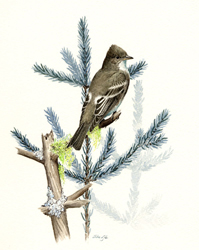Breeding Bird Atlases (BBA)
Find a Bird - BBA1
Breeding Bird Atlas 1 Species Accounts
Olive-sided Flycatcher
Contopus borealis
Egg Dates
June 8 to July 10
Number of Broods
one; may re-lay if first attempt fails.

A denizen of northern boreal forests, the Olive-sided Flycatcher is a local summer resident confined almost entirely to the higher elevations of Berkshire County. At the turn of the century, it nested rather sparingly in the Berkshires and northern Worcester County and inexplicably also nested in the pine barrens of southeastern Massachusetts (Wareham, Carver, Plymouth) and Cape Cod (Bourne, Falmouth, Mashpee, Cotuit). Brewster noted that the Olive-sided Flycatcher bred in low numbers within 20 miles to the north and west of Boston but by 1900 had almost entirely deserted the region. The southeastern breeders disappeared as well. During the Atlas period, it was confirmed at only one location (Mount Watatic) east of the Connecticut River.
The Olive-sided Flycatcher, like most flycatchers, is a notably late spring migrant. Seldom is an individual noted before mid-May, and most migrants pass through in late May and early June. Despite its rarity, a nesting Olive-sided Flycatcher seldom goes undetected. The loud, haunting, whistled song consists of three notes, well described phonetically as hip-three-cheers, with the introductory note often inaudible from a distance. The song is usually given from an exposed snag of a dead tree with a commanding view of the surrounding woodland. From its prominent perch, the bird will sally forth in quest of insects and then return repeatedly to the same location. During courtship, the male actively pursues the female.
The preferred nesting site is a swamp or bog in spruce forests. At the highest elevations, such as Mount Greylock and Mount Watatic, it nests in spruces unassociated with water. Mated pairs begin nest building in June. The nest is situated in a conifer, usually a spruce, near the end of a horizontal branch and is often hidden in a cluster of needles. Heights range from 5 feet to more than 50 feet. The habits of the species in western Massachusetts are little known. However, information does exist for 15 nests from the former breeding grounds in eastern parts of the Commonwealth. Of these nests, 2 were in Red Cedar from 14 to 50 feet high, 1 in an apple (an unusual situation) at 12 feet, and 12 in Pitch Pines from 7 to 20 feet up and 3 to 5 feet out from the trunk, generally in a twig cluster. Most were in the vicinity of water (ACB).
The nest is constructed of twigs, mosses, and rootlets and is lined with finer materials. It is remarkably flat, thereby adding to the concealment afforded by the dense spruce or pines. The female alone incubates the three to four eggs for 14 to 16 days while the male perches conspicuously nearby, loudly proclaiming his territory, which he aggressively defends. Reported clutch sizes for 2 Massachusetts nests were three eggs each (ACB, DKW). When the young have hatched, both parents attend to the ravenous nestlings for a period of about three weeks before the young fledge. During this period, both adults utter a loud emphatic pip-pip-pip when a predator or intruder approaches the vicinity of the nest or fledglings. After undergoing a postjuvenile molt, the young essentially resemble the adults, but the distinctive white tufts at the base of the tail are often less conspicuous. Nestling and fledgling data is lacking for Massachusetts. The few confirmations were mostly of adults carrying food.
The southward migration to the wintering grounds in northern South America commences in mid-August, with the bulk of the migrants passing through in late August and early September. Reports of Olive-sided Flycatchers are rare after mid-September.
Map Legend and Data Summary
Atlas 1 data collected from 1975-1979


Note: rare and local in bogs and swampy coniferous areas at higher elevations; declining
Richard A. Forster



